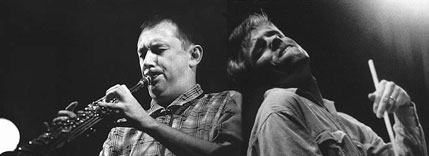

![]()
"In the world of saxophone music, players using extended techniques to make unusual sounds with the horn are common, but few have established a voice as original as John Butcher's. His saxophone acts as an extension of his own voice as he employs such techniques as growling and flutter tonguing to make his saxophone talk, sing, cry, whisper and laugh. What is more impressive is how he has incorporated all of this into a musical language that is both complicated and accessible. One of the central figures in Europe's avant-garde music scene."
SAN FRANCISCO BAY GUARDIAN
"Hemingway is an extraodinary and highly original drummer. Using mallets or his hands more frequently than sticks, and preferring arcs of rhythm to a continous beat, he shapes his solo pieces with concern for dynamic balance and thematic continuity. While Hemingway is not averse to employing unconventional techniques, in his hands the uncommon effect never becomes an end in itself."
BOSTON GLOBE
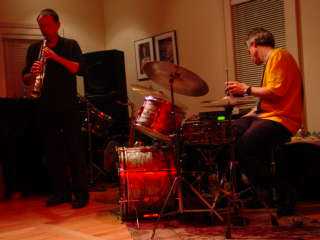
For US Bookings Contact: Gerry Hemingway
 JAZZ at MULH0USE-FRIDAY AUGUST 29, 2003 (review - L'Alsace)
JAZZ at MULH0USE-FRIDAY AUGUST 29, 2003 (review - L'Alsace)
One felt the unique, yesterday at the chapelle Saint Jean, with the duet at the summit of the saxophonist John Butcher and the drummer Gerry Hemingway.
"It is so beautiful that one cannot speak about it." It is by these words that Paul Kanitzer, director of Jazz in Mulhouse, introduced the duet of the British saxophonist John Butcher and the American drummer Gerry Hemingway. "That, it is sacred", comments a spectator on the way out. Conquered audience, whose intensity of listening is a measurement of the amazing performance of the duet.
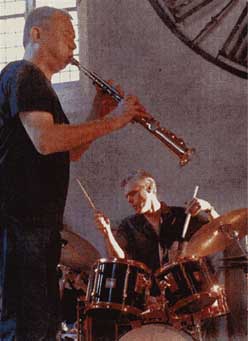 During one hour, they probed the minute together. Around a pivot note vibrated in a long behaviour, the saxophonist manages to make leave his instrument a harmonic spectrum of incredible richness.
During one hour, they probed the minute together. Around a pivot note vibrated in a long behaviour, the saxophonist manages to make leave his instrument a harmonic spectrum of incredible richness.
Hemingway produces the same effects, a pallet of sounds inside the sound, by cherishing a cymbal with the bow vigorously, by torturing with the palm of his hands the skins of its clear case.
One feels a rare control which makes it possible for the musicians to create an amazing score, never heard. Scintillating sascade luminous with the accents ravéliens, congestive éructations, strident sudden starts, whistles..
One passionately follows them in this sound exploration which while remaining confined on a territory at the exiguous borders, does not offer the same landscape twice,
The images march past. The emotion is born from the permanent astonishment. An astonishment which one owes as much to the extraordinary technical performance as with the purity and the aesthetic quality of the music.
FREDERIQUE MEICHLER, L'ALSACE
New Release !!!!! On Auricle Records
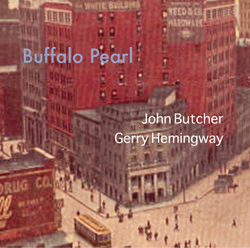
Buffalo Pearl (reviewed in AAJ - Mark Corroto)
There are some combinations in jazz that are simply magic, including the duos of Django Reinhardt and Stephane Grappelli; Stan Getz and Kenny Barron; and Peter Brotzmann and Han Bennink. Add to that list the teaming of John Butcher and Gerry Hemingway. Though not a new pairing—the saxophonist and drummer became acquainted in 1993 and released Shooters & Bowlers on Red Toucan in 2001— Buffalo Pearl is extremely compelling.
Both players are involved in projects too numerous to list, but what is significant is they are both well-known solo players. Perhaps Butcher, a former physicist, is best-known for his solitary work, extending the saxophone's sound through the invention of new techniques and electronics.
Buffalo Pearl was taken from a live 2005 performance in Buffalo, New York, and while the respectful crowd is never heard, the players project a radiant energy that maintains itself throughout.
Of the disc's five pieces, only "Head Nickel" goes for the obvious tenor versus drums blastoff. This power workout bridges the more subtle touches that the two masters bring to their live show. An evening hearing Brotzmann blowing waves of energy is always a treat, but within the context of listening to a recording, this is the superior experience.
The combination if Butcher's extended saxophone techniques and Hemingway's tactile expression—be it on drums, adding a bit of sampling, voice, or brushes—keeps things stimulating throughout. As Butcher flutters through "The Good Neighbor," Hemingway drives the drums at a breakneck pace and with an electronic pop and sizzle boiling. The pair relies on the faithful technique of tension and release, and noise and silence; all with an overarching transparency of purpose and clarity of sound.
Buffalo Pearl (reviewed in Paris TransAtlantic Magazine [Lent 2009]-Dan Warburton)
This decade has seen saxophonist John Butcher making several successful solo forays into the worlds of electroacoustic and environmental improvisation – the former best documented on his Fringes solo disc Invisible Ear, the latter on last year's Resonant Spaces (Confront) – but in case you'd forgotten how good he is at burning it up with a drummer, this latest offering on Gerry Hemingway's Auricle label will remind you. Not that Hemingway, despite impeccable free jazz credentials (think of all those killer Braxton albums for starters) is exactly a hard swingin' bebopper: his ear for timbral nuance and feeling for space is just as keen as, say, Burkhard Beins's. And his kit isn't entirely acoustic, either: on Buffalo Pearl he makes judicious and impressive use of a sampler too. Recorded as you might guess in that upstate NY city on April 17th 2005, it presents five carefully worked examples of the kind of in-the-moment interplay that has characterised both men's work for over 20 years, since Butcher's stay in John Stevens' SME and Hemingway's boisterous mid 80s debut with Braxton. Comparing this to the other Butcher outing reviewed above with AMM probably doesn't make much sense, but as I've been listening to them back to back lately I'm tempted to – and the saxophonist seems to be more at ease with Hemingway, more willing to take the initiative and display his formidable technical mastery, from tight flutter flurries to those meticulous split tones. Hemingway is no less impressive, and his excellent recording and the pair's post-production (another date was recorded at Roulette two days prior to the gig in Hallwalls – maybe we'll see that out and about shortly) capture every detail to perfection. A pearl for sure.–Dan Warburton Paris TransAtlantic Magazine
Buffalo Pearl (reviewed in Signal to Noise #53)
Buffalo Pearl is a very different encounter, which makes sense; drummer and electronician Gerry Hemingway may be as imposing as a Scottish rock formation, but he moves a lot faster. His drumming is full on, infused with the thrill of its essential athleticism, and Butcher pitches in with equal gusto. Which isn’t to suggest that they spend the whole set (recorded in concert in Buffalo, NY) blowing their brains out. Sections of “McGeist,” the stouthearted seventeen-minute journey at Buffalo Pearl’s heart, are highly detailed and restrained. But even in the quiet moments, there’s a feeling of unyielding intent here, of two men determined to make their points. Bill Meyer Signal to Noise #53
Buffalo Pearl (reviewed in AAJ - Italia)
Valutazione: 4 stelle
Anche il duo con il sassofono di John Butcher - praticato sin dal 2000 - stimola Gerry Hemingway alle più ardimentose velleità sonore: registrato nell'aprile del 2005 a Buffalo, Buffalo Pearl gioca ovviamente le sue carte a partire dall'aspetto timbrico, che per entrambi gli improvvisatori ha un ruolo centrale nell'esplorazione.
Strappi tribali, i margini dello stridere allungati come elastici dentro la pulsione in costante ridefinizione, esplosioni infuocate ["Head Nickel" è il momento che più si avvicina al furore dell'improvvisazione radicale più praticata] opposte a accenti quasi lirico-descrittivi [per quanto questa caratteristica si possa attagliare al carattere malmostoso dei due]: nelle cinque improvvisazioni che compongono il disco troviamo la coppia Hemingway/Butcher al suo meglio.
Tradotto in parole povere: consigliato agli amanti delle avventure sonore! Enrico Bettinello AAJ Italia
Red Toucan released "Bowlers & Shooters" in 2001, our first duo recording, culled from a performance in Chicago at HotHouse in the spring of 2000 and from a recording session we did in London's Gateway Studios a few months later. Here's one review (click here)more below... . We are currently at work on our second duo recording, stay tune for details.
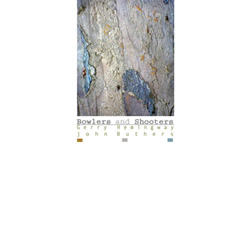
one final note issue #10 | spring
2002
John Butcher / Gerry Hemingway Shooters and Bowlers (Red Toucan)
review by Jason Bivins
Caged Clambroth (6:56) / Shift (17:15) / Clearies (3:04) / Shooters
and Bowlers (5:00) / Hay (3:41) / The Lightning Strike (5:59) / End of Cane
Cloud (8:42) / Jackpot (6:24). personnel:John Butcher (tenor, soprano sax) /
Gerry Hemingway (drums, percussion, vibraphone, harmonica, electronics). recorded:Hot
House, Chicago, 16 February 2000 (tracks 2 & 7) / Gateway Studios, London,
28 May 2000.
This reviewer had the good fortune to be at the Chicago show by these wonderful
musicians (which meant, owing to the bad fortune wrought that night by the scheduling
gods, I was unable to be at the Irene Schweizer solo concert at the Empty Bottle
- alas, life is about choices . . .). The pairing between the highly abstract,
microtonal saxophones of John Butcher and the more conventionally loquacious
(if no less inventive) Gerry Hemingway was something of a surprise at the time
- it's much more taken-for-granted now that they've come off their second tour
together. But it worked like a charm, and this fine recording documents how
such seemingly disparate styles can produce both great inner tension in the
music and also can result in brilliant explorations into shared territory.
Hemingway is in top form throughout this disc, using triggered electronics sparingly
and inventively alongside his thoughtfully textured kit work (including rubbed
drum heads, bowed cymbals, and so forth). In these registers, his playing meshes
easily with Butcher's evolved microscopic approach to saxophonics (buzzing metal,
whining split tones, hissing reed). Fans of Butcher's recent output and the
contemporary developments of his singular style will delight at hearing the
master on these pieces. Yet one of the more fascinating subplots of this duo
is the encounter between Hemingway's furious pulse-driven playing and Butcher's
voice. The saxophonist of course has no problems navigating this territory and
finding his voice therein; it is simply a context in which he does not often
find himself, and the results are pretty stimulating on long tracks like "Shift"
or "End of Cane Cloud." Not everything on the disc works quite as
well: I could do without "Hay," where Hemingway plays his harmonica
in a slightly hackneyed and frankly throwaway manner, though his take on vibes
("The Lightning Strike") is far better.
Overall, there is much intense focus and concentration on detail as Butcher
and Hemingway move through this stark and often silent terrain. Oriented more
towards abstract, even subliminal gestures than to Grand Events, these two create
music that burns with inner fire.
Jason Bivins, one final note
Shooters & Bowlers - jazzreview.com
The performances on this CD are simply music to my ears. This is not a case of my merely stating the obvious; I am using this cliché to underscore both how refreshing I find it musically and how another listener might easily dismiss its contents as noise. Butcher and Hemingway are free improvisers of the highest order and their collaboration is unique and wonderful.
Hemingway and Butcher have similar backgrounds in the avant-garde. The percussionist’s CV includes work with such artists as Anthony Braxton, John Zorn, Anthony Davis and Leo Smith, jazz artists whose compositions frequently push at the barrier between jazz and what is more commonly accepted as “Art” music. The London -based saxophonist Butcher cut his improvisational teeth playing the music of Stockhausen and has worked with the likes of Evan Parker and Derek Bailey, the latter a former Hemingway collaborator as well.
Bearing all this in mind, it comes as no surprise that a piece like “Caged Clambroth” recalls the early percussion compositions of John Cage (perhaps the title is intended as a pun?) or that Hemingway’s vibraphone playing on “The Lightning Strike” seems inspired by Cage’s “Suite for Toy Piano.” Both players display a healthy, light-hearted sense of humor on this cut and on the almost child-like “Hay” despite the fact that they are working in a format one tends to associate with the sturm und drang of John Coltrane and Rashid Ali or Peter Brotzman.
The duo is capable of intense and serious statements as well, as demonstrated on the epic jam “Shift” and by Butcher’s smoldering playing on the album’s finale “Jackpot.” This is dense, imaginative music that rewards every listen with a new discovery. Every listen, that is, made with open ears and mind.
Edward Kane Jazzreview.com
Bill Shoemaker - WIRE
- Jan 2002
Timing is everything in the creation of collaborations, and the timing was ripe
for saxophonist John Butcher and percussionist Gerry Hemingway to tour the US
in February 2000. Butcher had begun an impressive run of recordings on North
American labels with CDs on Wobbly Rail and Nuscope. Though Hemingway had a
lengthy history of collaborating with European improvisers, the release of Tom
and Gerry (Erstwhile) with synthesist Thomas Lehn signalled a deepening interest
in integrating free improvisation and MIDI-triggered samples.
As evidenced by the two longest pieces on Shooters and Bowlers, recorded at
the tour's Chicago stop, the resulting music was flinty and probing, prompting
London studio session three months later, which yielded six shorter, arguably
more formalised pieces. The album does not simply document the first meetings
of provocative, complimentary sensibilities, but a development of methods that
that initially shape an improvisation without determining its ultimate structure.
They make clear, deliberate choices in beginning a piece, like the soft, unpressured
blowing and metallic scraping of "Clear Clambroth", and the braying
call and response between soprano and harmonica on "Hay". However,
each improvisation on the album lurches in unanticipated directions that don't
undermine its inception so much as recast it.
Each modulation of texture reinforces the continuity of their exchanges. "Shift" spikes and ebbs over the course of 17 minutes. Central to its overall cohesion
is Hemingway's unflinching use of pulse and even patterns, and butcher's sureness
in elongating staccato bursts into loping legato, and in whittling a flowing
line until it is little more than a shaving. Still, this relatively calibrated
interaction is not the product of years, let alone decades of refinement, but
of exceptionally keen intuition. Butcher and Hemingway are simply on the same
page from the get-go.
Bill Shoemaker - WIRE - Jan 2002
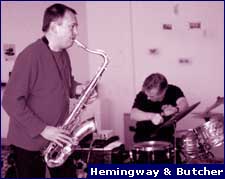 2nd US
tour
2nd US
tour
Nov 29th-Dec 7th, 2001
HotHouse Chicago, IL
November 30th-Madison, WI
December 1st-Kerrytown Concert House, Ann Arbor, MI
December 2nd-Grand Rapids, MI
December 3rd-Bloomington, IN
December 4th-Louisville, KY
December 5th-Project Space 211, Winston-Salem, NC
December 6th-Skylight Exchange, 405 1/2 Rosemary St, Chapel Hill, NC 9pm
December 7th-Red Room, Baltimore, MD
two views of our concert in Madison Wisconsin.....
an email from my sister-in-law, a paleobiologist teaching at the University of Wisconsin in Madison;
I found it completely different to listen with my eyes open versus with them shut. With my eyes open I felt distracted by watching, but with my eyes shut it became so interesting. (watching was interesting too, but it wasn't totally about the music.) At first I did what you suggested to the kids just before you started, which was to imagine a painting. But soon I began to see different scenes from the ancient history of earth and life, and quickly it became so vivid.
Specifically, in the first piece I heard: a tropical jungle (this seemed so obvious that I felt that others might be thinking the same thing). Then it went back to the carboniferous, with giant insects and dark forests. And then it was a beautiful rendition of the cambrian explosion (a relatively brief interval when all the major groups of invertebrates suddenly appear after 3 billion years of only single-celled things). It was chaotic but purposeful and full of life.
The second piece seemed confined to the first billion years of earth or so... the beginning of the piece seemed for sure the earliest earth with no life present, only physical processes like degassing, burbling lava and mud, tectonic sounds. Then I could imagine the origin of life, or at least early versions of cells competing in their funny chemical ways. This was perhaps the most interesting part, because I had never thought about the sound of chemistry before (but this seemed to be it). Then there was a loud part, which had to be meteorites, which were incredibly common very early in earth history. In fact, it is thought that giant meteorites probably struck the earth repeatedly in the first half billion years, vaporizing the proto-oceans and killing off whatever life might have existed. So that's how I heard your drum solo!
So I really felt energized by the music and found it extremely interesting. I didn't anticipate that I would hear it as a paleo-soundtrack. I always tell my students that learning about earth history has a strong aesthetic component as well as the factual part. whether or not they can see that, I know I feel that way. I think that most scientists have a deep aesthetic appreciation for what they study. But I was surprised at how vivid and strong was the connection that I felt with your music, even though you were probably not thinking about the cambrian explosion!
Dana H. Geary, Madison, WI.
A review from the Madison Daily News (Click Here)
Preview of February 2000 concert in Pittsburgh
Duets seem to be gaining more popularity in the realm of experimental/fringe jazz and, fortunately for us, Pittsburgh is catching the best of these intimate collaborations. Next week will see the performance of yet another promising duo, British saxophonist/composer John Butcher and American percussionist/composer Gerry Hemingway.
A largely self-taught saxophonist with a physics doctorate (in "the theoretical properties of charmed quarks"), Butcher has been reeding since the late '70s. At the onset of the '80s, he was working with several different jazz vehicles, among them the BBC Big Band Award-winning Chris Burns Group. He was also working with contemporary dance and music theater groups and was pursuing his growing interest in free-improvisation, experimenting with the unconventional sonorities and techniques that would inform much of his later work.
Butcher continues to distance himself and his music from the rigid strictures of traditional jazz. As he told Jon Morgan of Coda (to see this complete interview), "In leaving my student jazz days behind, I tried to improvise by discarding 90 percent of what the saxophone usually does ... On the saxophone there's quite a thin line, physically, between getting a miserable squeak or a fabulous chord. When the music's working, I think it creates its own connections and shapes that are more interesting than ones you might have tried to consciously impose."
A percussionist, multi-media collaborator, and composer whose pieces often feature newer compositional elements such as tapes and samplers, Gerry Hemingway has been creating and performing solo and ensemble works for more than a quarter of a century. He has recorded both acoustic and electro-acoustic solo percussion pieces, composed works commissioned by Arcadian Arts, trombonist David Titcomb, and clarinetist Don Byron, among others, and recently recorded for John Zorn!s Tzadik label. He has played with the likes of George Lewis, Anthony Davis, Leo Smith, and Cecil Taylor and was a core member of the legendary Anthony Braxton's Quartet from the early '80s to the early '90s.
Hemingway also shares, Butcher's unconventional approach to his instrument. In a 1996, interview on Northwestern University's radio station, WNUR, he reported, "I use a lot of different methods, I suppose you could say, as a composer. The one thing I was focused on in 1980 and up through 1985, and in which I'm still interested, is extended techniques, which is a way of describing a vocabulary I developed as a drummer. Both as an improviser and as a composer who was fond of experimentation, I would develop sound vocabulary that extended the possibilities of what the instrument was normally designed for."
CP Arts & Entertainment (Pittsburgh)
Writer: Jordan Weeks
Coda Interview with John Butcher